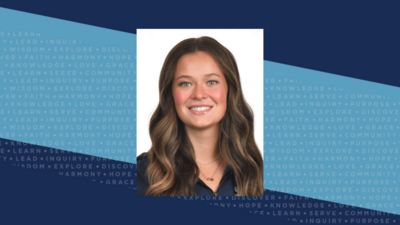Get to Know Concordia Nebraska's Buildings

As a student, staff or faculty member at Concordia Nebraska, chances are you’ve ventured into most of the buildings located on campus. From the recognizable Weller Hall to Borland Center for Music and Theatre, the newest addition, Concordia’s buildings are each come with a unique backstory.
Weller Hall
Weller Hall, named after J. George Weller, Concordia’s first president, was built in 1925 and expanded to include the current Weller Chapel in 1950. Though few classes take place here, it is a space for students and faculty from across campus to gather. Weller hosts daily chapel services at 11 a.m., as well as Wednesday night Praise and special services and performances throughout the academic year. It’s also been Concordia’s main administrative building ever since it first opened.
Founders Hall
Founders Hall is the place where Concordia began. In 1894, its doors opened as a 13-student three-year high school. The building was dedicated on November 18 of that year, and classes began on the 20th. Today, the Concordia family celebrates November 18 as “Founders’ Day.” Although these first students ate, learned and slept in Founders Hall, not as much takes place in the building today – its primary use is by the drama department, and specifically the costume shop.
Thom Leadership and Education Center
Thom, TLEC – call it what you want, but this building is one of Concordia’s most versatile. Its construction was completed in 2001, and today, students may take courses ranging from general education religion to upper-level psychology within its walls. Although its classrooms see many topics taught each day, the building is officially home to the Director of Christian Education department as well as Concordia’s education department.
Dunklau Center for Science, Math and Business
Dunklau is the second-newest building on campus and was completed in 2019. Its construction was primarily due to a generous donation – the largest in Concordia’s history – from the Rupert Dunklau Foundation. Dunklau, like Thom, is home to classes from a wide range of programs, but especially those of natural science, mathematics, and business. It contains two lecture halls, 11 laboratories, a greenhouse and research labs, in addition to classrooms and other common areas.
Link Library
J.T. Link was one of Concordia’s early professors and a leading player in the task of gaining accreditation for the university. Until the library’s construction, Concordia’s collection of books and other resources traveled from building to building as it grew. Today, students have access to Link’s more than 135,000 title collection, as well as the Academic Resource Center, study spaces and the Bartels Rock Museum in a single building.
Jesse Hall
Jesse Hall is another of Concordia’s oldest buildings. It originally opened as a residence hall in May 1924, and housed up to 100 students during a time when Concordia’s enrollment saw rapid growth. Now, the building is multipurpose: it contains the offices of many professors, the Marxhausen Gallery of Art, and is home to the Sower student newspaper, the Luke Scholars program, the counseling center and a few classrooms.
Borland Center for Music and Theatre
Concordia’s most recently renovated – and almost completely rebuilt – building is the Borland Center for Music and Theatre, which was completed and dedicated in 2023. Named for faithful university supporters Michael and Caryn Borland, the spacious building is campus’s go-to location for musical and theatre practice, instruction, and performance. It contains larger and more sophisticated rehearsal spaces for band, choir, and theatre activities to accommodate growing ensembles, as well as more than 20 practice rooms for all of Concordia’s musically inclined students.
Janzow Campus Center
Since it was finished in 1968, Janzow Campus Center has been the location of choice for Concordia students to hang out. When the modern dining hall was created in its lower level in the early 2000s, it also took its place on campus as the main dining location. Janzow now contains the student life offices, the health and wellness center, the 10:31 coffee shop and the Dog House, as well as the dining hall, mail room, bookstore and other amenities. It’s also open 24 hours a day for students’ use.
Walz Human Performance Complex
The Walz Human Performance Complex, or “Walz,” as it’s often called, was completed in 2009 and houses many of Concordia’s sports teams. Inside, the weight room, Friedrich Arena and the fieldhouse contribute to Walz’s place as one of the finest facilities in the Great Plains Athletic Conference. Also located in Walz are various athletic offices and classrooms.
Physical Education Center
The Physical Education Center, located just west of Walz, was dedicated in 1960 and renovated in 2015. The building is home to the Bulldog football and wrestling teams, where players have access to renovated locker rooms and practice spaces. The P.E. Center has its own gymnasium, weight room and wrestling mats.
Brommer Art Center
The Brommer Art Center was built in 1927 and named after C.F. Brommer, Concordia’s third president, who served the university from 1924-41. It originally served as a dining hall – until the mid 1990s! Today, it is – as its name suggests – home to Concordia’s art department. With a photography studio, spaces for ceramics and sculpture, a large art studio and smaller studios open to art students by application, Brommer is the building where artistic creativity flourishes at Concordia.
Dorm Buildings
With the construction of the apartment-style Jonathan dormitory in 2006, Concordia’s number of dorm buildings grew to 11. Today, these buildings house students in single- and double-occupancy rooms, as well as suites and apartments. These 11 dorm buildings bear names that are either Biblical or significant to Concordia’s past: Philip, Timothy, David, Jonathan, Esther, Dorcas, Ruth, Boaz, Obed, Strieter and Schuelke.
Center for Liturgical Art
Concordia’s Center for Liturgical Art (CLA), established in 2003 with the modern studio built in 2017, sits on the former site of the home of professor emeritus of art Reinhold Marxhausen and his wife, Doris. The studio is a permanent home for the CLA and its mission to spread the Gospel through visual means.
Concordia University, Nebraska is a university that emphasizes the Christ-centered message of the Gospel in a rigorous academic setting. It equips its students for service to both the church and the world, readying them not only with an academic degree but with a sense of God-given purpose that they can take into their future vocation, wherever it may lie. Schedule a visit today here.
Interested in visiting Concordia's buildings for yourself?
Related Stories


